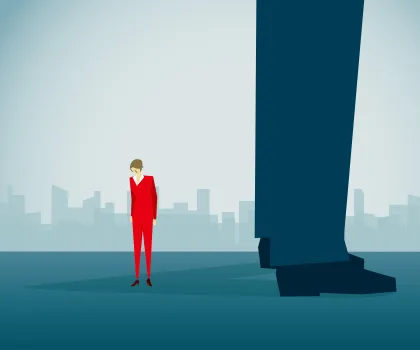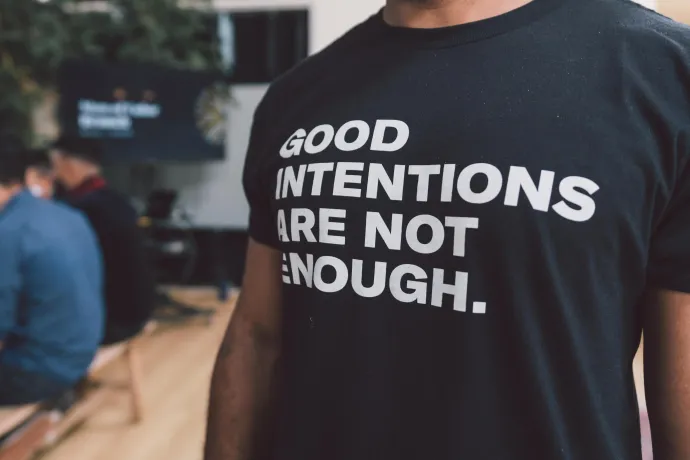Gender Bias: If You See Something, Say Something
Cass A. unpacks what gender discrimination looks like at work, and what you can do about it.
The year is 2010 and I am working an advanced technical help desk position – technical support for technical support. I receive questions when phone technicians are stumped on what to do next. My job is to teach people “how to fish” so they can quickly and efficiently resolve customer issues. I have been doing this for over a year and I’m good at my job. But suddenly something changes; people start treating me differently and it takes me a while to figure out why.
People don’t want me to teach them how to fish anymore. No longer am I treated as a personalized technical mentor or coach; I’m now more like a fast food drive thru attendant. People make their request, get the answer, and move on – a fast-as-possible transaction with no room for growth or knowledge sharing. Instead of teaching technicians how to work through a problem, they now say, “no, I trust you” and just push me for a quick answer. Why the change? I am the same person in the same role working with the same colleagues addressing the same standard questions. And I have received no mandates from management dictating a change in how I do my work.
The change people are responding to is my physical appearance as I begin my gender transition from female to male. I am growing a beard, my voice is dropping, and my body is changing. The default assumption of my gender is changing – from female to androgynous to very clearly male. People are treating me differently because they are seeing me differently. In our society, we treat genders differently – especially in the male dominated field of technology.
I was trained in the technical support field as a woman. I was told that I must always “show my work” – I can’t just give an answer. I have to prove that I know what I’m talking about, not dissimilar to how I was taught mathematics in elementary school. I show my work in my job to share my knowledge with my peers so that we can collectively grow together – to make a better environment for everyone to feel like they can succeed.
As a woman I am assumed incompetent until proven otherwise; as a man I no longer need to prove I know what I’m talking about.
I have heard the phrase “no, I trust you” so many times it still echoes in my ears. That phrase in and of itself isn’t the issue, but the fact that I didn’t hear it until I was perceived as a man is. Translation: as a woman I am assumed incompetent until proven otherwise; as a man I no longer need to prove I know what I’m talking about.
When you’re accustomed to oppression, privilege feels like a prank. My brain couldn’t conceive that the same people I had been working with for years would change how they treated me – especially because I respected and admired many of the people who now are telling me they trust me. I thought someone was pulling a fast one on me, just giving me a hard time.
As a man, I am trusted and competent. As a man, I am privileged – not because I’ve advanced in my knowledge but because I’m a man.
There is a good amount of research on how men and women are treated differently. However, I am the rare example of experiencing that treatment first hand. As a woman, customers often asked for my supervisor because they didn’t trust that a woman could answer their question. As a man, I never get asked that anymore. As a woman, my ideas were greeted by a slew of questions trying to poke a hole in my logic or find a flaw in my reasoning. As a man, my ideas are implemented immediately without question or investigation. As a man, I am trusted and competent. As a man, I am privileged – not because I’ve advanced in my knowledge but because I’m a man.
If you’re paying attention, you too have seen gender bias happening at work. You’ve seen women dismissed, passed up, or overlooked for reasons unrelated to their skillset or ability to perform. And you’ve been at a table of decision-makers with little or no female representation. Gender bias is ingrained into all areas of our lives, and we see it every day – whether we are aware of it or not.
Addressing gender bias means calling it out when it happens. If you see something, say something.
The real question, then, becomes: When you see or experience gender-based bias or discrimination, do you say or do anything about it? Because if you say or do nothing, you are complicit and are not acting as an ally to the women in your life. Addressing gender bias means calling it out when it happens. If you see something, say something. It means when there isn’t a woman at the table, bringing one in. It means asking why there are no female applicants considered for an open role or why a woman has never held a particular position before.
Addressing gender bias is not waiting to boost a women’s good idea until after the meeting, but doing it immediately where everyone can hear it. It means calling out misogynistic or discriminatory language when you hear it, even if it’s behind closed doors. If you don’t say something because you fear it will affect your job security, role, or responsibilities, then you are starting to understand what women have to deal with every day.
I stand with women because I know what it is like to be treated like a woman. But we don’t need to experience the same oppression or discrimination to care about it and take action. What we can do is validate what others are experiencing. We can empathize and relate to their reality. We can relate to being passed up on an opportunity because of an assumption made about us. We can relate to the fear of retribution that might happen if we speak up about unfair treatment. We can relate to being frustrated when you have the answer but no one is listening.
It is not the responsibility of the oppressed to secure equal treatment – it is the responsibility of us all.
I believe we have way more in common than we do different. And I believe that it is not the responsibility of the oppressed to secure equal treatment – it is the responsibility of us all. My challenge to you is to simply say something the next time you notice gender bias. Point it out. Ask why. Inquire further. Having the conversation is the first step to creating change. Together we can create a workplace where everyone has equal value.








We encourage you to share your thoughts on your favorite social platform.